Face Preference in Infants at Six and Nine Months Old: The Effects of Facial Attractiveness and Observation Experience
Abstract
:1. Introduction
2. Experiment 1
2.1. Methods
2.1.1. Participants
2.1.2. Stimuli
2.1.3. Procedure
2.1.4. Apparatus
2.1.5. Data Analysis
2.2. Results and Discussion
2.2.1. Verification of the Validity of the Movie Stimuli
2.2.2. Preference Looking
3. Experiment 2
3.1. Methods
3.1.1. Participants
3.1.2. Stimuli
3.1.3. Procedure
3.1.4. Apparatus
3.1.5. Data analysis
3.2. Results and Discussion
3.2.1. Verification of the Validity of the Movie Stimuli
3.2.2. Preference Looking
4. General Discussion
Author Contributions
Funding
Acknowledgments
Conflicts of Interest
References
- Grammer, K.; Thornhill, R. Human (Homo sapiens) facial attractiveness and sexual selection: The role of symmetry and averageness. J. Comp. Psychol. 1994, 108, 233–242. [Google Scholar] [CrossRef]
- Rhodes, G.; Proffitt, F.; Grady, J.M.; Sumich, A. Facial symmetry and perception of beauty. Psychonom. Bull. Rev. 1998, 5, 659–669. [Google Scholar] [CrossRef] [Green Version]
- Langlois, J.H.; Roggman, L.A. Attractive faces are only average. Psychol. Sci. 1990, 1, 115–121. [Google Scholar] [CrossRef]
- Feinberg, D.R.; Jones, B.C.; Debruine, L.M.; Moore, F.R.; Law-Smith, M.J.; Cornwell, R.E.; Tiddeman, B.P.; Boothroyd, L.G.; Perrett, D.I. The voice and face of women: One ornament that signals quality? Evol. Hum. Behav. 2005, 26, 398–408. [Google Scholar] [CrossRef]
- Johnston, V.S.; Hagel, R.; Franklin, M.; Fink, B.; Grammer, K. Male facial attractiveness: Evidence for hormone-mediated adaptive design. Evol. Hum. Behav. 2001, 22, 251–267. [Google Scholar] [CrossRef]
- Penton-Voak, I.S.; Jones, B.C.; Little, A.C.; Baker, S.; Tiddeman, B.; Burt, D.M.; Perrett, D.I. Symmetry, sexual dimorphism and facial proportions and male facial attractiveness. Proc. R. Soc. B Biol. Sci. 2001, 268, 1617–1623. [Google Scholar] [CrossRef] [Green Version]
- Perrett, D.I.; Lee, K.J.; Penton-Voak, I.; Rowland, D.; Yoshikawa, S.; Burt, D.M.; Henzi, S.P.; Castles, D.L.; Akamatsu, S. Effects of sexual dimorphism on facial attractiveness. Nature 1998, 394, 884–887. [Google Scholar] [CrossRef]
- Cunningham, M.R. Measuring the physical in physical attractiveness: Quasi-experiments on the sociobiology of female facial beauty. J. Personal. Soc. Psychol. 1986, 50, 925–935. [Google Scholar] [CrossRef]
- Geldart, S.; Maurer, D.; Carney, K. Effects of eye size on adults’ aesthetic ratings of the faces and 5-month-olds’ looking times. Perception 1999, 28, 361–374. [Google Scholar] [CrossRef] [PubMed]
- Kuraguchi, K.; Taniguchi, K.; Ashida, H. The impact of baby schema on perceived attractiveness, beauty, and cuteness in female adults. SpringerPlus 2015, 4, 164. [Google Scholar] [CrossRef] [Green Version]
- Golle, J.; Mast, F.W.; Lobmaier, J.S. Something to smile about: The interrelationship between attractiveness and emotional expression. Cogn. Emot. 2014, 28, 298–310. [Google Scholar] [CrossRef] [PubMed]
- Ueda, R.; Kuraguchi, K.; Ashida, H. Asymmetric effect of expression intensity on evaluations of facial attractiveness. SAGE Open 2016, 6, 1–6. [Google Scholar] [CrossRef] [Green Version]
- Little, A.C. Domain specificity in human symmetry preferences: Symmetry is most pleasant when looking at human faces. Symmetry 2014, 6, 222–233. [Google Scholar] [CrossRef] [Green Version]
- Møller, A.P. Developmental stability and fitness: A review. Am. Nat. 1997, 149, 916–932. [Google Scholar] [CrossRef]
- Møller, A.P.; Thornhill, R. Bilateral symmetry and sexual selection: A meta-analysis. Am. Nat. 1998, 151, 174–192. [Google Scholar] [CrossRef]
- Rhodes, G. The evolutionary psychology of facial beauty. Annu. Rev. Psychol. 2006, 57, 199–226. [Google Scholar] [CrossRef] [Green Version]
- Zajonc, R.B. Attitudinal effects of mere exposure. J. Personal. Soc. Psychol. 1968, 9, 1–27. [Google Scholar] [CrossRef] [Green Version]
- Moreland, R.L.; Beach, S.R. Exposure effects in the classroom: The development of affinity among students. J. Exp. Soc. Psychol. 1992, 28, 255–276. [Google Scholar] [CrossRef]
- Peskin, M.; Newell, F.N. Familiarity breeds attraction: Effects of exposure on the attractiveness of typical and distinctive faces. Perception 2004, 33, 147–157. [Google Scholar] [CrossRef]
- Cooper, P.A.; Maurer, D. The influence of recent experience on perceptions of attractiveness. Perception 2008, 37, 1216–1226. [Google Scholar] [CrossRef] [Green Version]
- Saxton, T.K.; Little, A.C.; DeBruine, L.M.; Jones, B.C.; Roberts, S.C. Adolescents’ preferences for sexual dimorphism are influenced by relative exposure to male and female faces. Personal. Individ. Differ. 2009, 47, 864–868. [Google Scholar] [CrossRef] [Green Version]
- Langlois, J.H.; Ritter, J.M.; Roggman, L.A.; Vaughn, L.S. Facial diversity and infant preferences for attractive faces. Dev. Psychol. 1991, 27, 79–84. [Google Scholar] [CrossRef]
- Langlois, J.H.; Roggman, L.A.; Casey, R.J.; Ritter, J.M.; Rieser-Danner, L.A.; Jenkins, V.Y. Infant preferences for attractive faces: Rudiments of a stereotype? Dev. Psychol. 1987, 23, 363–369. [Google Scholar] [CrossRef]
- Bushnell, I.W.R.; Sai, F.; Mullin, J.T. Neonatal recognition of the mother’s face. Br. J. Dev. Psychol. 1989, 7, 3–15. [Google Scholar] [CrossRef]
- Pascalis, O.; de Schonen, S.; Morton, J.; Deruelle, C.; Febre-Grenet, M. Mother’s face recognition by neonates: A replication and an extension. Infant Behav. Dev. 1995, 18, 79–85. [Google Scholar] [CrossRef]
- Bushnell, I.W.R. Discrimination of faces by young infants. J. Exp. Child Psychol. 1982, 33, 298–308. [Google Scholar] [CrossRef]
- Quinn, P.C.; Yahr, J.; Kuhn, A.; Slater, A.M.; Pascalis, O. Representation of the gender of human faces by infants: A preference for female. Perception 2002, 31, 1109–1121. [Google Scholar] [CrossRef] [Green Version]
- Kelly, D.J.; Quinn, P.C.; Slater, A.M.; Lee, K.; Ge, L.; Pascalis, O. The other-race effect develops during infancy: Evidence of perceptual narrowing. Psychol. Sci. 2007, 18, 1084–1089. [Google Scholar] [CrossRef] [Green Version]
- Liao, H.-I.; Yeh, S.-L.; Shimojo, S. Novelty vs. familiarity principles in preference decisions: Task-context of past experience matters. Front. Psychol. 2011, 2. [Google Scholar] [CrossRef] [Green Version]
- Ramsey, J.L.; Langlois, J.H.; Hoss, R.A.; Rubenstein, A.J.; Griffin, A.M. Origins of a stereotype: Categorization of facial attractiveness by 6-month-old infants. Dev. Sci. 2004, 7, 201–211. [Google Scholar] [CrossRef]
- Griffey, J.A.F.; Little, A.C. Infant’s visual preferences for facial traits associated with adult attractiveness judgements: Data from eye-tracking. Infant Behav. Dev. 2014, 37, 268–275. [Google Scholar] [CrossRef] [PubMed]
- Rhodes, G.; Geddes, K.; Jeffery, L.; Dziurawiec, S.; Clark, A. Are Average and Symmetric Faces Attractive to Infants? Discrimination and Looking Preferences. Perception 2002, 31, 315–321. [Google Scholar] [CrossRef] [PubMed] [Green Version]
- Amso, D.; Johnson, S.P. Learning by selection: Visual search and object perception in young infants. Dev. Psychol. 2006, 42, 1236–1245. [Google Scholar] [CrossRef] [PubMed] [Green Version]
- Frank, M.C.; Amso, D.; Johnson, S.P. Visual search and attention to faces during early infancy. J. Exp. Child Psychol. 2014, 118, 13–26. [Google Scholar] [CrossRef] [Green Version]
- Frank, M.C.; Vul, E.; Johnson, S.P. Development of infants’ attention to faces during the first year. Cognition 2009, 110, 160–170. [Google Scholar] [CrossRef] [Green Version]
- Oakes, L.M. Sample size, statistical power, and false conclusions in infant looking-time research. Infancy 2017, 22, 436–469. [Google Scholar] [CrossRef]
- Cruz-Khalili, A.; Bettencourt, K.; Kohn, C.S.; Normand, M.P.; Schlinger, H.D. Use of Repeated Within-Subject Measures to Assess Infants’ Preference for Similar Others. Front. Psychol 2019, 10, 2239. [Google Scholar] [CrossRef] [Green Version]
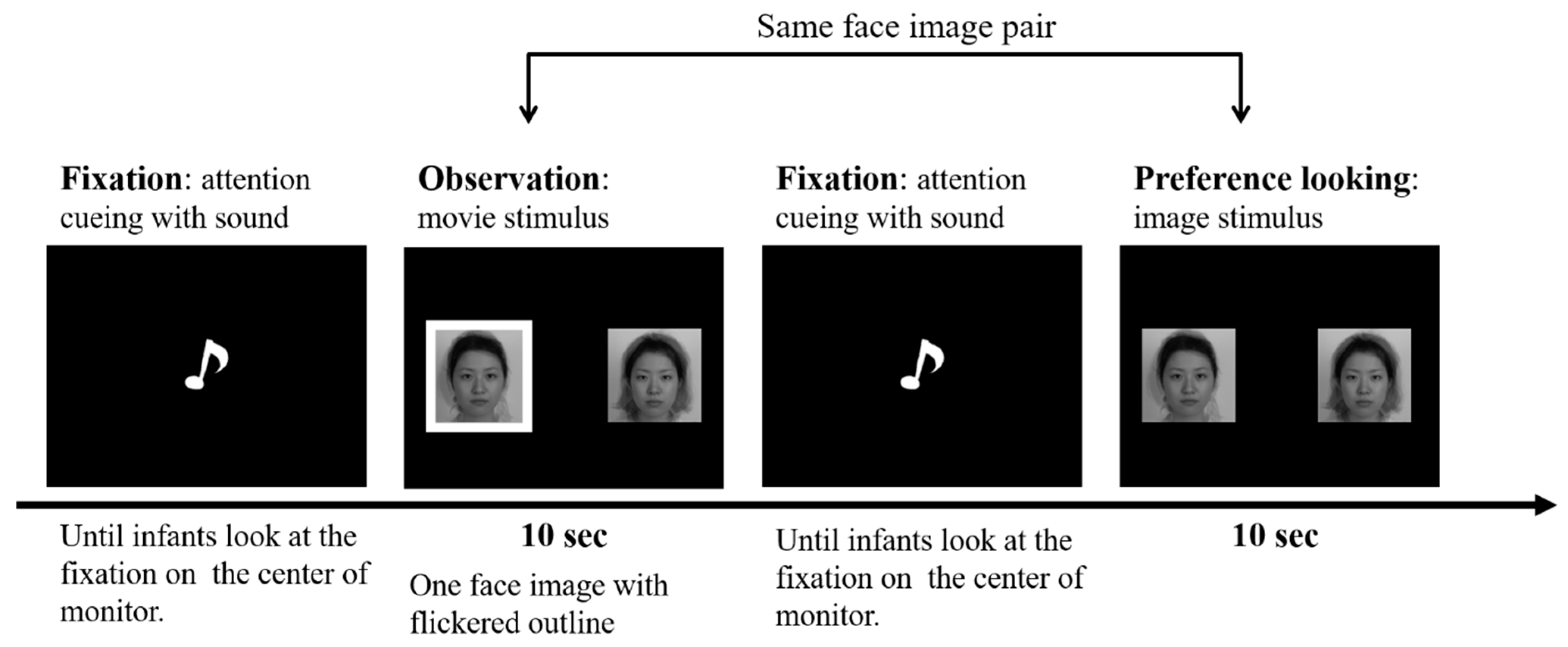
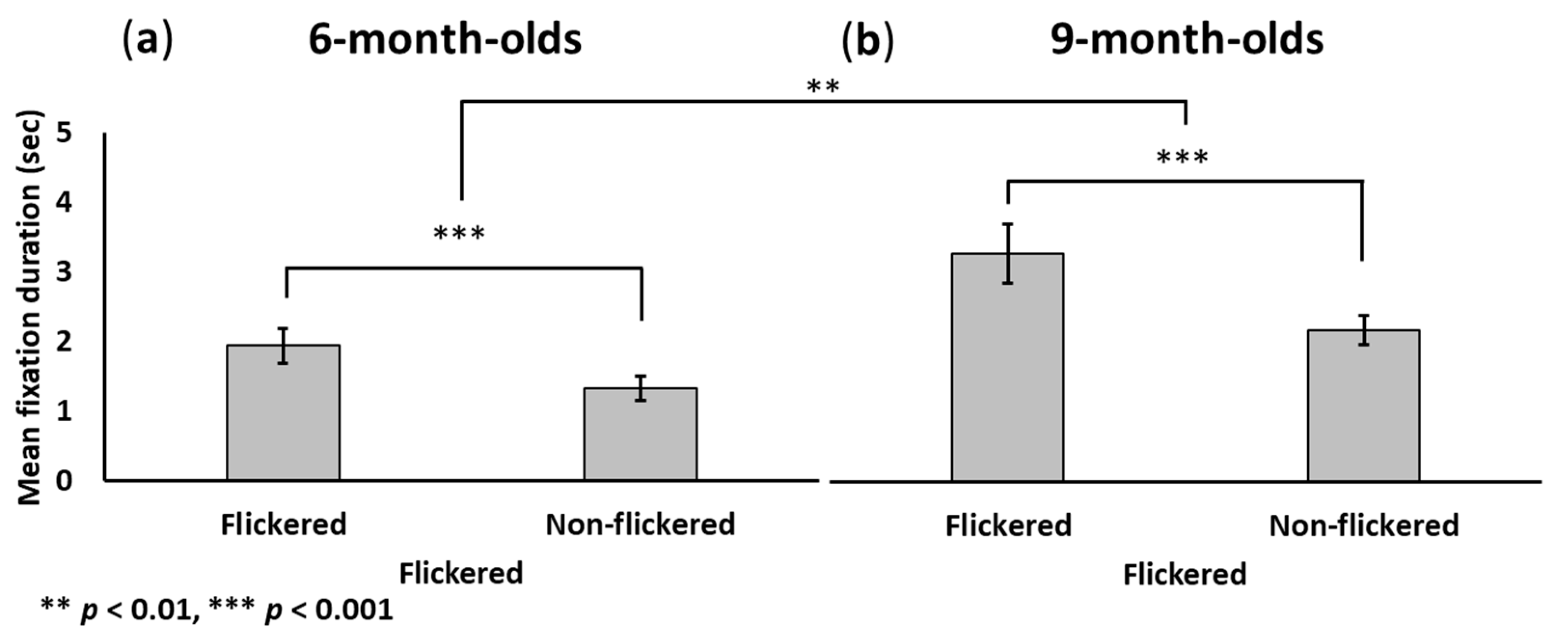

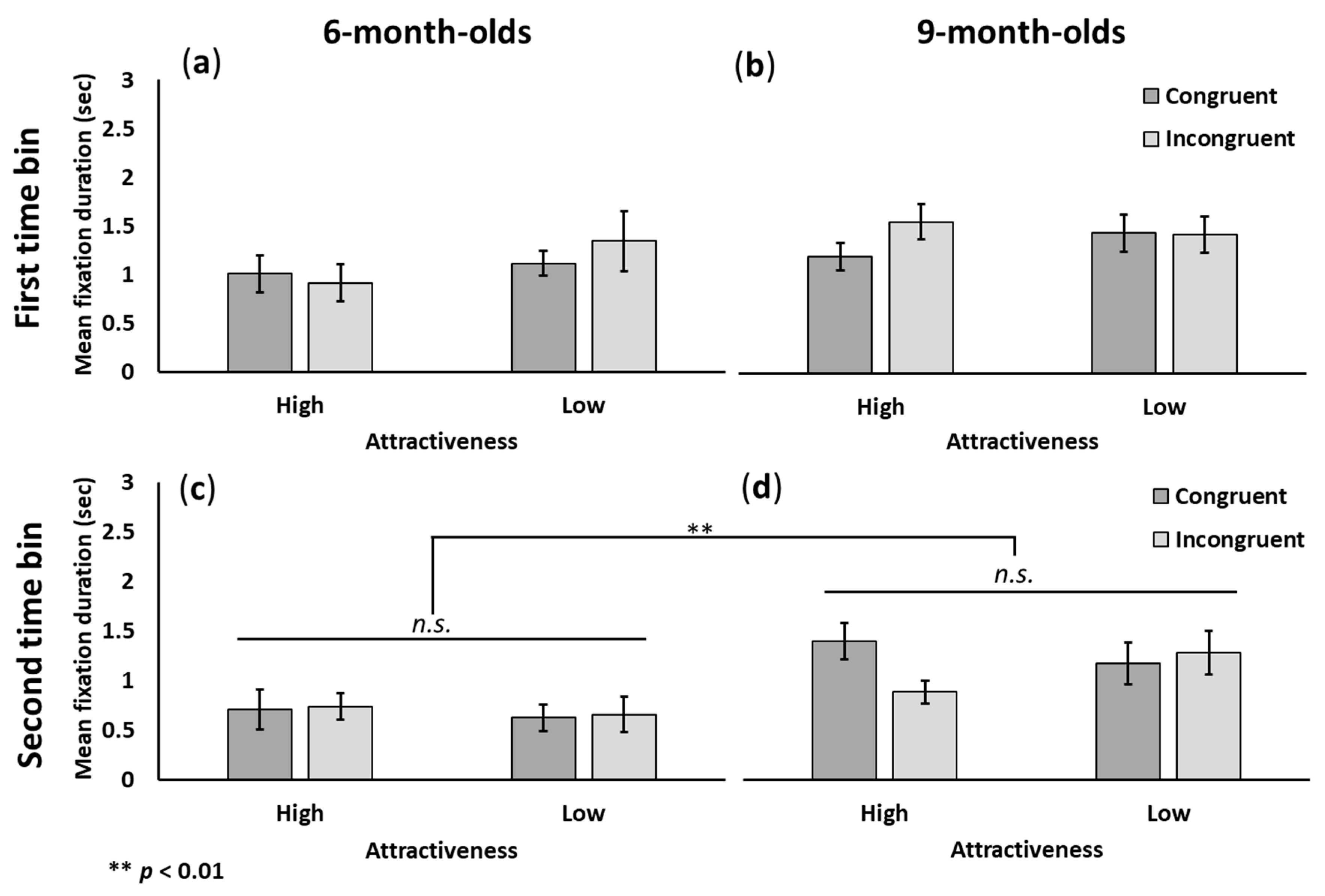
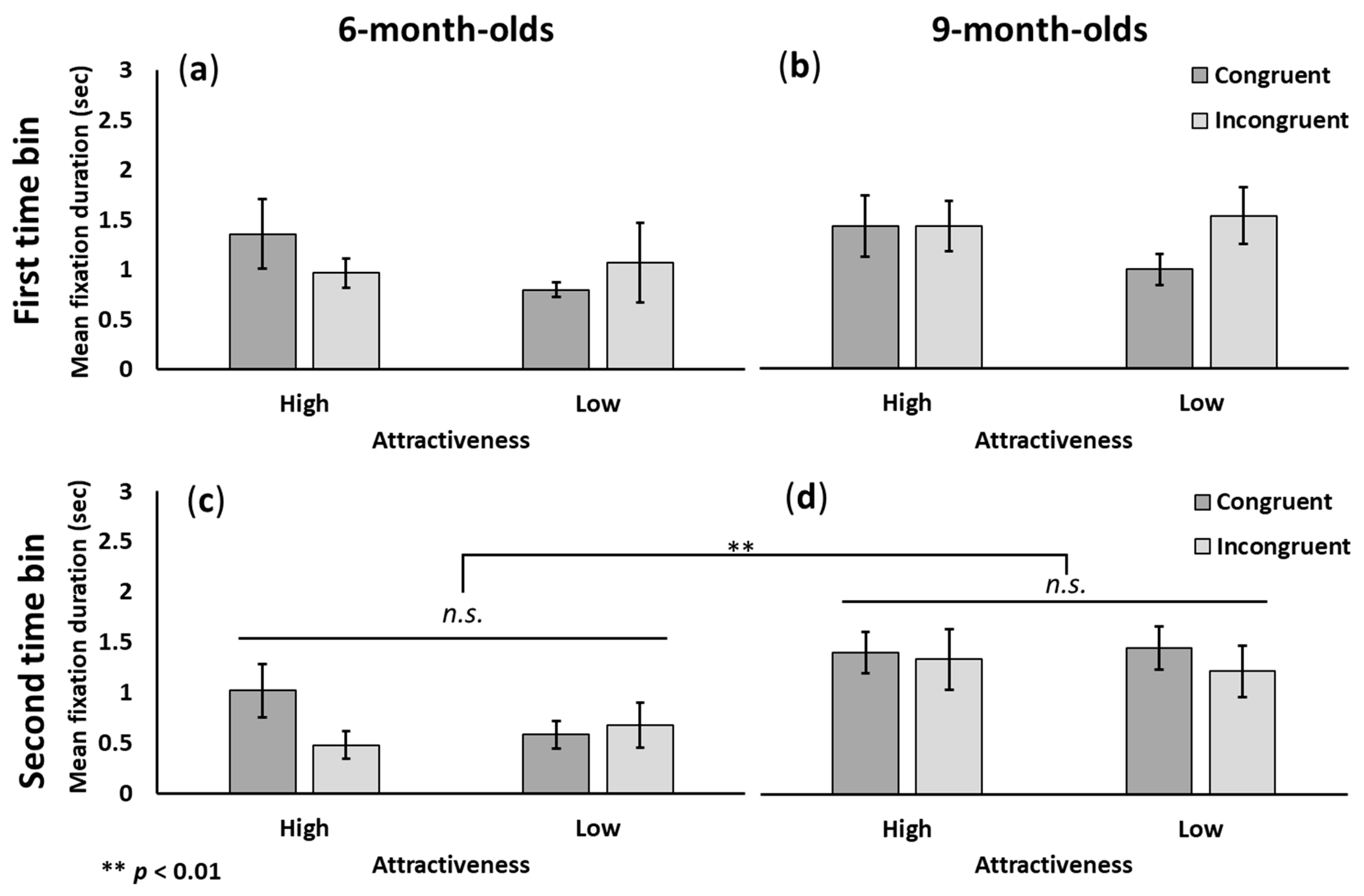
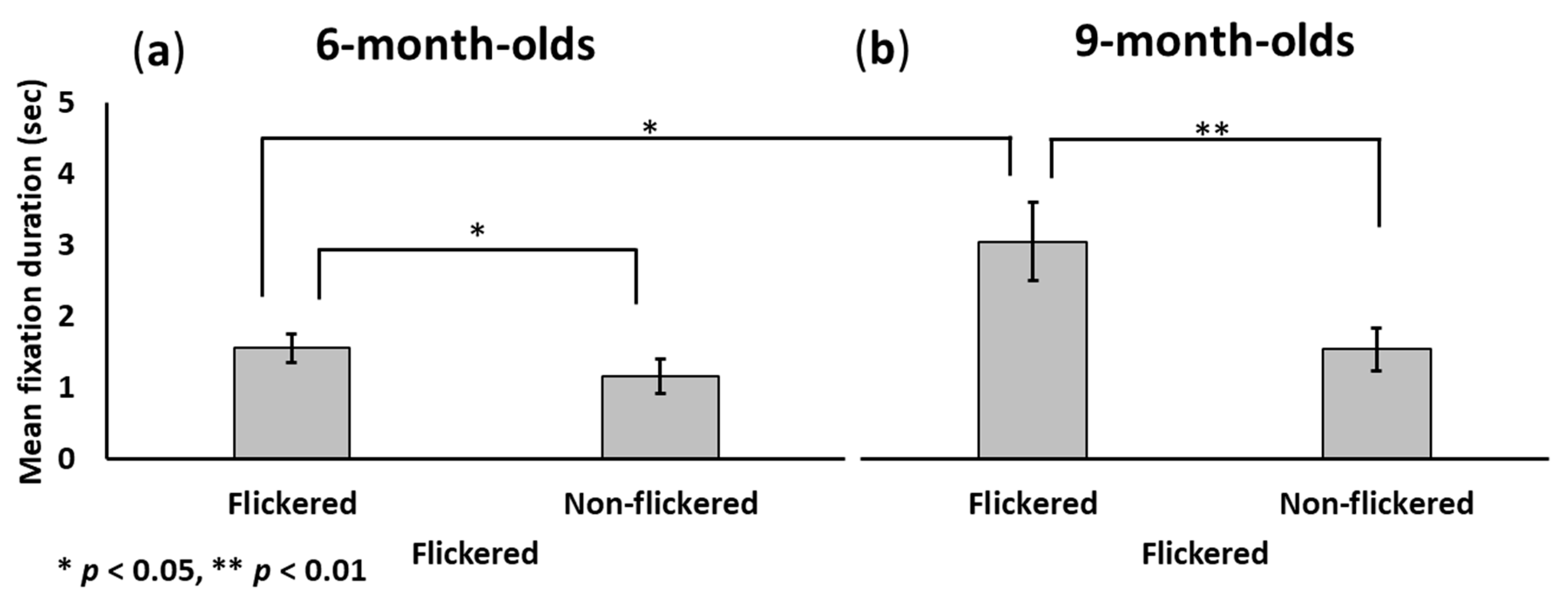

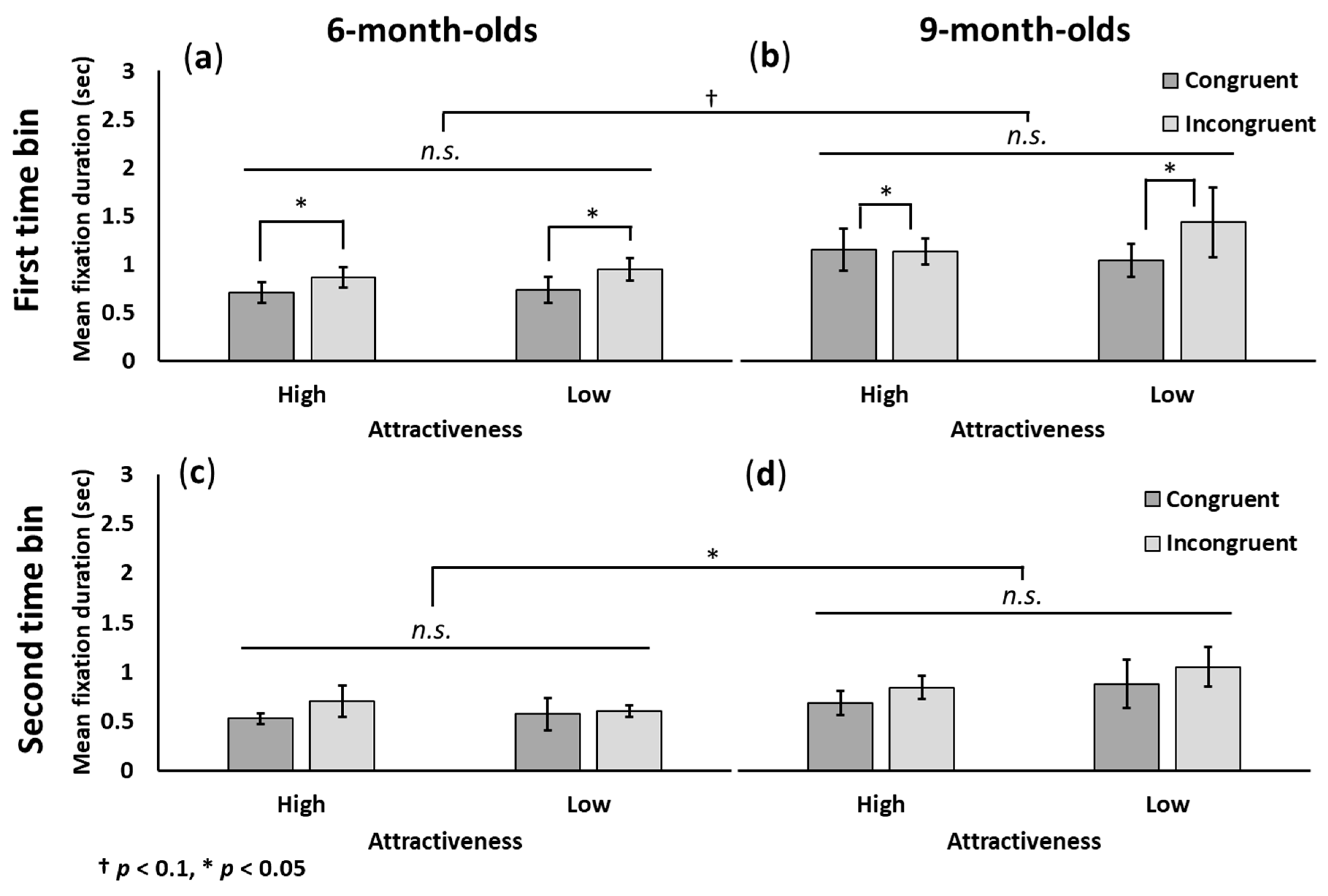

© 2020 by the authors. Licensee MDPI, Basel, Switzerland. This article is an open access article distributed under the terms and conditions of the Creative Commons Attribution (CC BY) license (http://creativecommons.org/licenses/by/4.0/).
Share and Cite
Kuraguchi, K.; Taniguchi, K.; Kanari, K.; Itakura, S. Face Preference in Infants at Six and Nine Months Old: The Effects of Facial Attractiveness and Observation Experience. Symmetry 2020, 12, 1082. https://doi.org/10.3390/sym12071082
Kuraguchi K, Taniguchi K, Kanari K, Itakura S. Face Preference in Infants at Six and Nine Months Old: The Effects of Facial Attractiveness and Observation Experience. Symmetry. 2020; 12(7):1082. https://doi.org/10.3390/sym12071082
Chicago/Turabian StyleKuraguchi, Kana, Kosuke Taniguchi, Kei Kanari, and Shoji Itakura. 2020. "Face Preference in Infants at Six and Nine Months Old: The Effects of Facial Attractiveness and Observation Experience" Symmetry 12, no. 7: 1082. https://doi.org/10.3390/sym12071082
APA StyleKuraguchi, K., Taniguchi, K., Kanari, K., & Itakura, S. (2020). Face Preference in Infants at Six and Nine Months Old: The Effects of Facial Attractiveness and Observation Experience. Symmetry, 12(7), 1082. https://doi.org/10.3390/sym12071082




